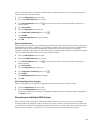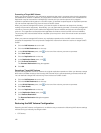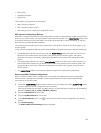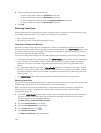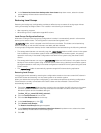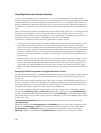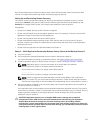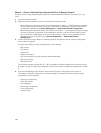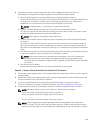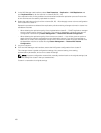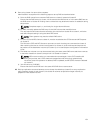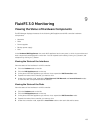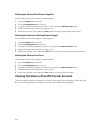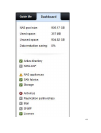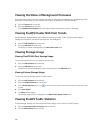
5. Ensure that cluster B is used to temporarily serve client requests during the fail over time.
Administrators must perform the following steps to set up DNS and authentication:
a) Point the DNS names from customer DNS server to cluster B instead of cluster A.
Ensure that the DNS server on cluster B is the same as the DNS server or in the same DNS farm as
the DNS server of cluster A. Existing client connections may break and may need to be re-
established. You must unmount and remount the NFS Exports on the client.
NOTE: Complete steps b, c, and d only for single volume failovers.
b) On DNS, manually update the DNS entry for the NAS volume that was failed over.
This step is to repoint end users that are accessing this volume from cluster A to cluster B, while
the end users keep accessing it using the same DNS name.
NOTE: Client systems may need to refresh DNS cache.
c) To force CIFS and NFS clients to cluster B, we also must delete the CIFS shares and NFS exports
on cluster A.
This forces the CIFS and NFS clients to reconnect, at such time they are connected to cluster B.
After restoring the source volume’s configuration on cluster B, all of the shares and exports will
be present on the destination volume (on cluster B), so no share/export configuration information
is lost.
d) The failed over volume now can be accessed using the exact same DNS name and share name as
it was when hosted on cluster A, except now it is hosted on cluster B.
NOTE: NFS mounts must be un-mounted and mounted again. Active CIFS transfers fail
during this process, but if CIFS shares are mapped as local drives, they automatically
reconnect once the replication is deleted, DNS is updated, and NFS/CIFS shares are deleted
on cluster A.
e) Join AD server or LDAP/NIS.
Ensure that the AD and LDAP are in the same AD/LDAP farm or same server.
Phase 3 — Restore Cluster A Fail Back From Cluster B To Cluster A
1. Fix the reason that caused cluster A to fail (replace hardware, replace disk, and so on), and if required
reinstall FluidFS.
2. Rebuild the cluster (use the settings for cluster A that you saved earlier), format the NAS reserve, and
set up the network (client, SAN, and IC) as before.
3. Log on to cluster B and set up the replication partnership between cluster B and cluster A.
For more information on setting up replication partners, see Adding a Replication Partnership.
4. Create replication policy for all the source volumes in cluster B to target volumes in cluster A.
NOTE: Replication policy is a one to one match on volume base, for example:
Source volume B1 (cluster B) to target volume A1 (cluster A)
Source volume B2 (cluster B) to target volume A2 (cluster A)
…………………………
Source volume Bn (cluster B) to target volume An (cluster A)
NOTE: FluidFS v2 supports auto generate target volume during addition of the replication
policy. For FluidFS 1.0, you must create the target volumes in cluster B and make sure that the
volume size is big enough to accommodate the corresponding source volume data in cluster A.
149



